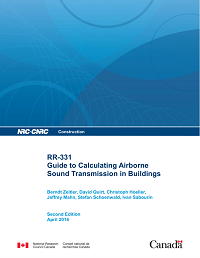 |
Dr. Christoph Hoeller is a Research Officer in the Acoustics Group at the National Research Council Canada. He is responsible for a range of different projects pertaining to sound transmission in buildings and human perception of sound. The current focus of his work is on supporting the transition to ASTC metrics in building regulations in Canada by developing tools and guidelines in collaboration with Canadian industry partners. Dr. Hoeller obtained an MSc from RWTH Aachen University in Germany and a Ph.D. from the University of Liverpool in the UK. He is a member of the Acoustical Society of America, the Canadian Acoustical Association, the German Acoustics Association, and the International Institute of Acoustics and Vibration. Dr. Hoeller serves on the ASTM committees on building and environmental acoustics, as well as the Canadian mirror committees for ISO standards on building acoustics. |
 |
Dr. Jeffrey Mahn is a Research Officer in the Acoustics Group at the National Research Council Canada. His areas of expertise include flanking transmission in buildings and measurement methods. Dr. Mahn obtained MScs from Washington University in St. Louis and the Technical University of Denmark in Copenhagen, Denmark and a Ph.D. from the University of Canterbury in Christchurch, New Zealand. He is a member of the Institute of Noise Control Engineering and the Acoustical Society of America. |
Tools and Guidelines for the Calculation of Apparent Sound Transmission Class (ASTC) Ratings
Outils et lignes directrices pour le calcul de l’indice de transmission du son apparent (ITSA)
 |
The 2015 edition of the National Building Code of Canada (NBCC) introduced significant changes to the requirements for the acoustic separation between dwelling units. While the requirements in previous editions of the NBCC were given in terms of the sound transmission class (STC) rating, the new requirements in the 2015 edition are given in terms of the apparent sound transmission class (ASTC) rating. The STC rating is based on laboratory measurements and only describes the sound transmission through a single building element. The ASTC rating quantifies the sound insulation of the complete building system, i.e. taking into account sound transmission through the separating element and sound transmission via flanking paths such as common floors or ceilings. The ASTC rating is therefore a better descriptor for the sound insulation that the building occupants will actually experience.
In collaboration with Canadian industry partners, the National Research Council Canada (NRC) has developed tools and guidelines to support the transition from STC requirements to ASTC requirements. The tools and guidelines include a number of research reports which are available from the NRC Publication Archive as well as soundPATHS, the free online application for the determination of ASTC ratings of different building constructions.
This seminar will provide an overview of the new requirements in the NBCC, presenting the various ways to demonstrate compliance. The seminar will highlight the tools and guidelines developed by the NRC for practitioners, including relevant research reports and soundPATHS. The manual calculation of ASTC ratings using data from NRC reports will be demonstrated for a range of different construction types. Seminar participants will acquire knowledge about the new requirements in the NBCC and the physical basics of flanking sound transmission, and will learn where to find information and how to perform the necessary calculations to determine ASTC ratings for a range of construction types.
 |
 |
(c) 2015-2024, Canadian Acoustical Association. All right reserved.

